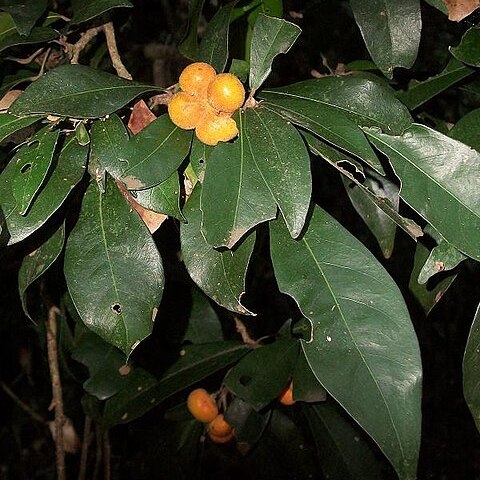Male flowers (not collected in our area as yet, description based on Tanganyika material) on ferruginous-stellate-pubescent pedicels 4–7 mm. long articulated above the base; calyx deeply 4–6-lobed, densely ferruginous-stellate-tomentose outside, tube up to 1·5 mm. long, glabrous within; lobes 5–10 × 2·5–5 mm., elliptic to obovate-elliptic with acute apices, with 3–5 longitudinal nerves, stellate-pubescent within the upper half, minutely papillose below; androphore 2·5–4·5 mm. long, glabrous except for a circle of stellate hairs at the base or densely pubescent, with 5–6 anthers in a single series at the apex and 4 vestigial pubescent or subglabrous carpels immersed in the top.
Leaf-lamina up to 15 × 7 cm., subcoriaceous, purplish-red when young, elliptic to oblanceolate or obovate-elliptic, apex obtusely acuminate, margin entire or sinuate, base broadly cuneate or narrowly rounded, glabrous on both surfaces, midrib prominent on both surfaces, nerves in 8–12 pairs, prominent on both surfaces but particularly beneath, venation reticulate; petiole up to 5·5 cm. long, with a dark-brown-stellate-tomentellous pulvinus just below the lamina; stipules 5 mm. long, caducous, subulate-lanceolate, brown-tomentose.
Female flowers as in the male but with the pedicels up to 1 (2) cm. long and the part above the articulation markedly sulcate; carpels 3–4, densely stellate-tomentose, biovulate; styles up to 3 mm. long, tomentose; stigmas 1 × 0·5–1·25 mm., patent or recurved, papillose; anthers 5, sessile, surrounding the base of the carpels.
Tree, up to 20 m high. Petiole with swollen apical portion tomentose. Fruit subglobose to oblique ellipsoid, 10 x 13-18 x 20 mm, rind rather thin and brittle at maturity. Flowers brownish.
Follicles 1–1·8 × 1·4–2 cm., sessile or subsessile, obliquely ellipsoid to obovoid, rounded or mucronate at the apex, ferruginously tomentellous, 1–2-seeded.
Tree 6–17 (24) m. tall, evergreen, dioecious; young branches densely dark-brown-tomentellous; bark rough.
Seeds 13–16 × 8–11 mm., ellipsoid, with a brown rugulose testa.
Flowers 1–8-nate in fascicles on 1–3-year-old wood.
A small tree.

